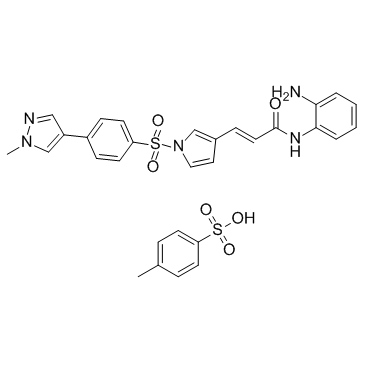4SC-202

4SC-202 structure
|
Common Name | 4SC-202 | ||
|---|---|---|---|---|
| CAS Number | 1186222-89-8 | Molecular Weight | 619.711 | |
| Density | N/A | Boiling Point | N/A | |
| Molecular Formula | C30H29N5O6S2 | Melting Point | N/A | |
| MSDS | N/A | Flash Point | N/A | |
Use of 4SC-202Domatinostat tosylate (4SC-202) is a selective class I HDAC inhibitor with IC50 of 1.20 μM, 1.12 μM, and 0.57 μM for HDAC1, HDAC2, and HDAC3, respectively. It also displays inhibitory activity against Lysine specific demethylase 1 (LSD1). |
| Name | (E)-N-(2-amino-phenyl)-3-{1-[4-(1-methyl-1H-pyrazol-4-yl)-benzenesulfonyl]-1H-pyrrol-3-yl}-acrylamide toluene-4-sulfonate |
|---|---|
| Synonym | More Synonyms |
| Description | Domatinostat tosylate (4SC-202) is a selective class I HDAC inhibitor with IC50 of 1.20 μM, 1.12 μM, and 0.57 μM for HDAC1, HDAC2, and HDAC3, respectively. It also displays inhibitory activity against Lysine specific demethylase 1 (LSD1). |
|---|---|
| Related Catalog | |
| Target |
HDAC-3:0.57 μM (IC50) HDAC-2:1.12 μM (IC50) HDAC-1:1.2 μM (IC50) HDAC-11:9.7 μM (IC50) HDAC-5:11.3 μM (IC50) HDAC-10:21 μM (IC50) HDAC-9:50 μM (IC50) |
| In Vitro | Domatinostat tosylate significantly reduces proliferation of all epithelial and mesenchymal UC cell lines (IC50 0.15-0.51 μM), inhibits clonogenic growth and induces caspase activity[1]. Domatinostat tosylate provokes apoptosis activation in CRC cells, while caspase inhibitors (z-VAD-CHO and z-DVED-CHO) significantly alleviate Domatinostat tosylate-exerted cytotoxicity in CRC cells. Meanwhile, Domatinostat tosylate induces dramatic G2-M arrest in CRC cells. Further studies show that AKT activation might be an important resistance factor of Domatinostat tosylate. Domatinostat tosylate-induced cytotoxicity is dramatically potentiated with serum starvation, AKT inhibition (by perifosine or MK-2206), or AKT1-shRNA knockdown in CRC cells. On the other hand, exogenous expression of constitutively active AKT1 (CA-AKT1) decreases the sensitivity by Domatinostat tosylate in HT-29 cells. Notably, Domatinostat tosylate, at a low concentration, enhances oxaliplatin-induced in vitro anti-CRC activity[2]. Domatinostat tosylate treatment induces potent cytotoxic and proliferation-inhibitory activities against established HCC cell lines (HepG2, HepB3, SMMC-7721) and patient-derived primary HCC cells. Domatinostat tosylate induces apoptosis signal-regulating kinase 1 (ASK1) activation, causing it translocation to mitochondria and physical association with Cyp-D[3]. |
| In Vivo | Oral gavage of Domatinostat tosylate inhibits HT-29 xenograft growth in nude mice, and when combined with oxaliplatin, its activity is further strengthened[2]. |
| References |
| Molecular Formula | C30H29N5O6S2 |
|---|---|
| Molecular Weight | 619.711 |
| Exact Mass | 619.155945 |
| PSA | 183.14000 |
| LogP | 7.41720 |
| 4sc-202 |
| (2E)-N-(2-Aminophenyl)-3-(1-{[4-(1-methyl-1H-pyrazol-4-yl)phenyl]sulfonyl}-1H-pyrrol-3-yl)acrylamide 4-methylbenzenesulfonate (1:1) |
| 2-Propenamide, N-(2-aminophenyl)-3-[1-[[4-(1-methyl-1H-pyrazol-4-yl)phenyl]sulfonyl]-1H-pyrrol-3-yl]-, (2E)-, 4-methylbenzenesulfonate (1:1) |